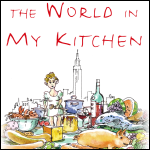Food Arts

October 2007 -
COVER STORY:
Europe: The Past Finds A Future"
A lovely lost-in-time region of France is embracing modern technology to save traditional agriculture and artisanal products. Colette Rossant reports. Photos by Andrea Bucci.
 Le Perche is the best kept secret of the Parisian hinterland. About two hours from Paris and a quick 30 miles west of Chartres, the region is part of Basses Normandy. With little industry, no metropolitan sprawl, and few tourists Le Perche virtually unchanged since the 17th Century. But now its status as a protected area under the capital Parcs Naturels system is taking it into the modern world, while ironically capitalizing on its oldest artisanal traditions.
Le Perche is the best kept secret of the Parisian hinterland. About two hours from Paris and a quick 30 miles west of Chartres, the region is part of Basses Normandy. With little industry, no metropolitan sprawl, and few tourists Le Perche virtually unchanged since the 17th Century. But now its status as a protected area under the capital Parcs Naturels system is taking it into the modern world, while ironically capitalizing on its oldest artisanal traditions.
About 15 years ago, the French government asked Parliament to create 44 "Parcs Naturels Regionaux." There are now 50 of these regional nature parks, located in 23 different regions; they make up about 7 million hectares (17.3 million acres or 13% of France). The purpose of these parks is to protect and manage their natural resources, develop their social and economic potential, control urban sprawl and educate the public.
One of the most successful of these parks is Le Parc Naturel Regional du Perche, created in 1980 and headquartered in the Manoir de Courboyer, a magnificent castle near the picturesque village of Noce. Under the direction of its chairman Jacques Dussutour, and his associates Patrick Hoguer and Jean-Claude Lenoir, the Parc Naturel Regional du Perche began an energetic campaign to encourage the region’Äôs agricultural traditions and protect its bucolic landscape of rolling meadows and lush forests. The Parc succeeded beyond its wildest dreams, since its farmers were eager to maintain quality and preserve old traditions while developing fresh solutions using technology, modern marketing ideas, and the Internet. Many fled their 9 to 5 jobs to go back to farming, a rare event in modern France. These farmers were assisted not only by the Parc, but also by a key institution, the EcoMusee (Eco-Museum) du Perche, created by the government to help preserve and teach the culture and traditions of the region.
The success story of Le Perche is most vividly told in the stories of the farmers and artisans who are responsible for the products -- bread, snails, goat cheese, Calvados -- that are revitalizing the local economy.
(The full article is available in the print edition of Food Arts, October 2007 issue.)
(back to Food Arts page)
(home)

